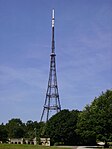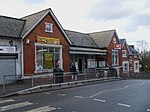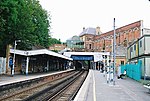Crystal Palace (High Level) railway station
Crystal Palace, LondonDisused railway stations in the London Borough of SouthwarkFormer London, Chatham and Dover Railway stationsPages with no open date in Infobox stationRailway stations in Great Britain closed in 1917 ... and 7 more
Railway stations in Great Britain closed in 1944Railway stations in Great Britain closed in 1954Railway stations in Great Britain opened in 1865Railway stations in Great Britain opened in 1919Railway stations in Great Britain opened in 1946Urban legendsUse British English from January 2018

Crystal Palace (High Level) was a railway station in South London. It was one of two stations built to serve the new site of the Great Exhibition building, the Crystal Palace, when it was moved from Hyde Park to Sydenham Hill after 1851. It was the terminus of the Crystal Palace and South London Junction Railway (CPSLJR), which was later absorbed by the London, Chatham and Dover Railway (LCDR).
Excerpt from the Wikipedia article Crystal Palace (High Level) railway station (License: CC BY-SA 3.0, Authors, Images).Crystal Palace (High Level) railway station
Farquhar Road, London
Geographical coordinates (GPS) Address Nearby Places Show on map
Geographical coordinates (GPS)
| Latitude | Longitude |
|---|---|
| N 51.4214 ° | E -0.0785 ° |
Address
Bowley Close Regional Rehabilitation Centre
Farquhar Road
SE19 1SZ London (London Borough of Southwark)
England, United Kingdom
Open on Google Maps











